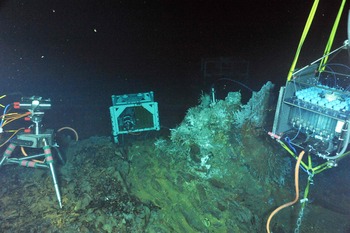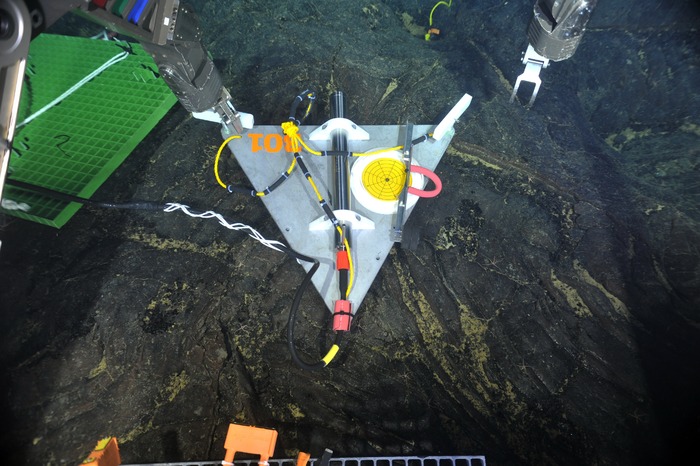Leg 1, VISIONS'14 UW College of the Environment and School of Oceanography undergraduate student, Don Setiawan, scripted and produced this video about the building and installation of an underwater high definition camera that is now installed on Axial Seamount at the hydrothermal vent called Mushroom. Video credit: NSF-OOI/UW/CSSF; V13 & V14

During ROPOS Dive R1729, a digital-still camera (left), a mass spectrometer (middle) and a fluid- and microbial-DNA sampler (right) were installed in the International District Hydrothermal Field at the vent called El Gordo. A titanium "hat" rests on top of the structure in a tubeworm and limpet patch. Inside the "hat" are temperature probes and intake nozzles for the fluid and DNA sampler. Photo credit: NSF-OOI/UW/CSSF; Dive R1729; V14.
The OOI Cabled observatory reaches some of the most extreme environments on Earth:
- Hydrothermal vents on active submarine volcanoes that emit >300°C acidic fluids rich in carbon dioxide and hydrogen sulfide
- Deep-ocean waters at pressures 300 times greater than those we experience on land
- Areas of gas hydrates with exposed methane-ice deposits on the seafloor
- An ocean basin where storms routinely produce >30-foot waves and sustained winds of >40-50 knots.
To understand the processes that operate in the oceans requires development of novel sensor arrays that can withstand harsh environments over time. With ocean science community input, over 130 instruments that includes a diverse suite of >30 different types was chosen to be installed on the Cabled Array. The high power and bandwidth is providing unprecedented data return from this sensor suite in real-time from the seafloor and over full-ocean water depths on an array of six cabled moorings. Also enabled are returns of high-definition video imagery and high-definition digital stills of vents, methane seeps, and the life that thrives in these extreme environments. Control of these sensors through the OOI Cyberinfrastructure and the Operations Management Center at the University of Washington allows adaption of sampling rates, profiling rates, and view angles in response to dynamic events in the oceans. Such events could include an erupting volcano; large and small seismic events on the Cascadia Subduction Zone that may be linked to release of methane ice into the ocean; coastal and ocean storms; and El Niño and La Niña perturbations to ocean temperature. The >100 instruments now installed on the Cabled Array allow monitoring of geophyscial, geological, chemical and biological processes within these dynamic ocean environments.
The confluence of nanotechnology, ever-increasing computational power, and installation of high-power and bandwidth cables into the oceans will likely lead to unprecedented advancements in ocean sensing within the next decade. High power within submarine environments allows sensors routinely used in land-based laboratories to be exported to the oceans. Example sensors include mass and raman spectrometers for detailed chemical analyses of vent, seep, and ocean fluids and in situ DNA sensors and flow cytometers for genomic analyses. Ample expansion capabilities on the OOI Cabled Array is now allowing scientists to adapt and deploy sensors such as these to deep- and shallow-ocean environments.
A wide variety of instruments have been installed at cabled network study sites.
- Acoustic Doppler Current Profiler
- Benthic Experiment Package
- Benthic Flow Meter
- Bottom Pressure and Tilt Meter
- Conductivity-Temperature-Depth (CTD)
- Dissolved Oxygen Sensors
- Digital Still Camera
- High-Definition Video Camera
- Hydrophone, Broadband
- Hydrophone, Low-Frequency
- Mass Spectrometer
- Optical Attenuation Sensor
- pH and Carbon Dioxide Sensors
- Pressure Sensor
- Remote Access Fluid and DNA Sampler
- Resistivity Probe
- Seismometer, Broadband Ocean-Bottom
- Seismometer, Short-Period Ocean-Bottom
- Thermistor Array
- Turbulent-Flow Current Meter (VEL3D)


